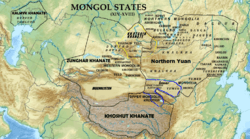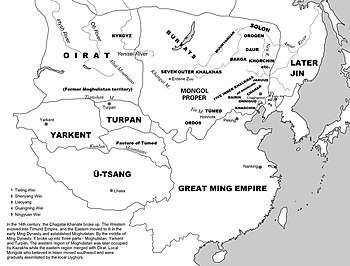Timeline of the Oirats
13th century
| Year | Date | Event |
|---|---|---|
| 1207 | Jochi subjugates the 'forest peoples' - Kyrgyz, Oirat, and Buryat[1] | |
| 1208 | Quduqa Bäki of the Oirats submits to Genghis Khan[2] | |
| 1260-1264 | Toluid Civil War: The Four Oirat (Choros, Torghut, Dörbet, and Khoid) is formed in support of Ariq Böke against Kublai Khan[2] |
14th century
| Year | Date | Event |
|---|---|---|
| 1388 | Jorightu Khan Yesüder, a descendant of Ariq Böke, kills Uskhal Khan Tögüs Temür and occupies the Northern Yuan throne with the backing of the Oirats[3] | |
| 1399 | The Four Oirat break away from Northern Yuan[4] |
15th century
| Year | Date | Event |
|---|---|---|
| 1414 | April | Second Mongol Campaign: Ming forces engage Oirats at the Tuul River, suffering heavy casualties, but ultimately prevail through the use of heavy cannon bombardments[5] |
| 1423 | August | Fourth Mongol Campaign: The Yongle Emperor launches an offensive against Arughtai only to find out he had already been defeated by the Oirats[6] |
| 1433 | The Oirats install Taisun Khan as leader of the Eastern Mongols[4] | |
| 1449 | July | Tumu Crisis: Esen Taishi of the Oirats and de facto ruler of the Northern Yuan launches an invasion of the Ming dynasty[7] |
| 4 August | Tumu Crisis: The Zhengtong Emperor departs from Beijing to personally confront Esen Taishi[8] | |
| 30 August | Tumu Crisis: The Ming rearguard is defeated[9] | |
| 1 September | Tumu Crisis: The Ming army is annihilated and the Zhengtong Emperor is captured by Esen Taishi[10] | |
| 27 October | Esen Taishi lays siege to Beijing but fails to take it and withdraws after 5 days[11] | |
| 1451 | Esen Taishi declares himself Yuan Emperor, which causes widespread dissent among his followers[4] | |
| 1454 | Esen Taishi is killed and the Northern Yuan is once more split into two portions between the Oirats and Eastern Mongols[12] | |
| 1457 | The Oirats invade the Uzbek Khanate and defeat Abu'l-Khayr Khan, plundering the cities on the Syr Darya[13] | |
| 1469 | The Oirats occupy Mobei[14] | |
| 1472 | The Oirats invade Moghulistan and defeat Yunus Khan[15] | |
| 1480 | Dayan Khan pushes the Oirats westward[14] |
16th century
| Year | Date | Event |
|---|---|---|
| 1507-82 | Altan Khan expel the Oirats from Mongolia[16] | |
| 1587 | Kharkhul repels an attack by Ubasi Khong Tayiji[17] |
17th century
| Year | Date | Event |
|---|---|---|
| 1607 | Oirat emissaries reach the Russians at Tara[18] | |
| 1608 | A group of Khoshut Oirats raid the Nogai Horde[19] | |
| 1616 | The first Russian embassy reaches the Oirats[16] | |
| 1620 | Kharkhul of the Choros clan attacks Ubasi Khong Tayiji but is defeated and the Oirats are forced to retreat into Siberia[20] | |
| 1622 | Oirats lay siege to Kuznetsk but fail to take it[21] | |
| 1623 | Kharkhul unites the Four Oirat and defeat Ubasi Khong Tayiji[20] | |
| 1625 | Kalmyk Khanate: The Torghut chieftain Kho Orluk moves 50,000 families west[22] | |
| 1628 | Kalmyk Khanate: The Kalmyks attack the Nogai Horde, displacing them[23] | |
| 1634 | Dzungar Khanate: Kharkhul dies and is succeeded by his son Erdeni Batur, who establishes the Dzungars on the upper Emil River south of the Tarbagatai Mountains[24] | |
| 1636 | Güshi Khan of the Khoshut responds to a Gelug invitation and invades Qinghai with 10,000 troops[24] | |
| 1637 | Güshi Khan kills Choghtu Khong Tayiji and proceeds to invade Tibet[24] | |
| 1642 | Khoshut Khanate: Güshi Khan conquers Tibet and bestows supreme authority over the region to the 5th Dalai Lama, who reciprocates by granting him the title of Chogyal (Dharma King)[24] | |
| 1644 | Kalmyk Khanate: Kho Orluk is killed while pursuing the fleeing Nogais and is succeeded by Shukhur Daichin[22] | |
| 1646 | Shukhur Daichin, Erdeni Batur and Güshi Khan send tribute to the Qing dynasty[17] | |
| 1651 | Kalmyk Khanate: The Kalmyks inflict a massive defeat on the Crimean Khanate and Nogais[19] | |
| 1653 | Dzungar Khanate: Erdeni Batur dies and is succeeded by his son Sengge[25] | |
| 1661 | Kalmyk Khanate: Shukhur Daichin is succeeded by Puntsug[26] | |
| 1667 | Dzungar Khanate: Dzungars and Khakas defeat a Russian force and lay siege to Krasnoyarsk, reducing its inhabitants to starvation; Sengge defeats Erinchin Lobsang Tayiji[21] | |
| 1668 | Kalmyk Khanate: Puntsug joins the Russians in attacking the Crimean Khanate[22] | |
| 1670 | Kalmyk Khanate: Puntsug is succeeded by Ayuka Khan[26] | |
| 1671 | Dzungar Khanate: Sengge is assassinated and succeeded by his younger brother Galdan Boshugtu Khan[25] | |
| 1678 | Dzungar conquest of Altishahr: Ismail Khan drives out to the Aq Taghliq Khoja Afaq Khoja, who seeks help from the 5th Dalai Lama, who in turn writes a letter to the Dzungar Khanate for help.[27] | |
| 1679 | Dzungar conquest of Altishahr: Galdan Boshugtu Khan conquers Hami and Turpan[25] | |
| 1680 | Dzungar conquest of Altishahr: Galdan Boshugtu Khan conquers Kashgar, Yarkand, and Khotan, killing Ismail's family. Abd ar-Rashid Khan II is installed as ruler.[28] | |
| 1682 | Dzungar Khanate: Riots break out, forcing Abd ar-Rashid Khan II to flee; his brother Muhammad Imin Khan succeeds him[29] | |
| 1684 | Dzungar Khanate: Galdan Boshugtu Khan takes Tashkent and Sairam[25] | |
| 1686 | Dzungar Khanate: Galdan Boshugtu Khan attacks Andijan[25] | |
| 1688 | Dzungar–Qing Wars: Galdan Boshugtu Khan invades Mongolia with 30,000 troops and defeats the Tüsheet Khan Chikhundorj, annexing the region[30] | |
| 1689 | Dzungar Khanate: While Galdan Boshugtu Khan was at war, his nephew Tsewang Rabtan seized the throne in Dzungaria[30] | |
| 1690 | 3 September | Battle of Ulan Butung: Galdan Boshugtu Khan leads 20,000 troops into battle with a Qing army 300 km north of Beijing, ending with Dzungar withdrawal[30] |
| 1693 | Dzungar Khanate: Muhammad Imin Khan attacks the Dzungars but is overthrown by Afaq Khoja, whose son Yahiya Khoja is enthroned[29] | |
| 1695 | Dzungar Khanate: Afaq Khoja and Yahiya Khoja are killed in a rebellion[29] | |
| 1696 | Battle of Jao Modo: The Qing dynasty invades Mongolia with 100,000 troops in three columns. Galdan Boshugtu Khan suffers defeat against the Western Route Army but manages to escape.[30] | |
| Dzungar Khanate: Akbash Khan is enthroned but the begs of Kashgar refuse to acknowledge him. Dzungar troops are brought in by Akbash to enforce his rule. However the Dzungars install Mirza Alim Shah Beg; so ends the Yarkent Khanate and Chagatai rule.[31] | ||
| 1697 | 4 April | Dzungar–Qing Wars: Galdan Boshugtu Khan dies in the Altai Mountains[30] |
| Dzungar–Qing Wars: ʿAbdu l-Lāh Tarkhān Beg rebels against the Dzungar Khanate in Hami[32] | ||
| 1698 | Dzungar–Qing Wars: Qing dynasty occupies Hami[33] |
18th century
| Year | Date | Event |
|---|---|---|
| 1710 | Dzungar Khanate: Dzungars demolish a Russian fort on the Biya River[34] | |
| 1717 | Khoshut Khanate: The Dzungars invade and kill Lha-bzang Khan, ending the Khoshut Khanate[35] | |
| 1720 | Chinese expedition to Tibet (1720): The Qing dynasty expels the Dzungars from Tibet, beginning the period of Tibet under Qing rule[35] | |
| Dzungar–Qing Wars: Amin Khoja leads a rebellion in Turpan against the Dzungar Khanate and defects to the Qing dynasty[33] | ||
| 1724 | Kalmyk Khanate: Ayuka Khan is succeeded by Tseren Donduk Khan[26] | |
| 1727 | Dzungar Khanate: Tsewang Rabtan dies and is succeeded by his son Galdan Tseren[35] | |
| 1732 | Dzungar–Qing Wars: The Dzungars attack Amin Khoja, who takes his people to settle in Guazhou[33] | |
| 1735 | Kalmyk Khanate: Tseren Donduk Khan is succeeded by Donduk Ombo Khan[26] | |
| 1737 | Dzungar–Qing Wars: Abuse by the Dzungars cause residents of the Tarim Basin to flee to the Qing dynasty[32] | |
| 1741 | Kalmyk Khanate: Donduk Ombo Khan is succeeded by Donduk Dashi Khan[26] | |
| 1745 | Dzungar Khanate: Galdan Tseren dies and is succeeded by his son Tsewang Dorji Namjal[36] | |
| 1750 | Dzungar Khanate: Tsewang Dorji Namjal is overthrown by his cousin Lama Dorji[36] | |
| 1752 | Dzungar Khanate: Dawachi takes control of the khanate with the aid of Amursana[37] | |
| 1754 | Dzungar–Qing Wars: The Dörbet and Amursana defect to the Qing dynasty[37] | |
| 1755 | Dzungar–Qing Wars: The Qing dynasty sends 50,000 troops in two columns against the Dzungars, meeting little resistance, and complete the destruction of the khanate in just 100 days, however Amursana revolts in the aftermath[33] | |
| 1757 | Amursana flees the Qing dynasty, dying in Tobolsk[37] | |
| 1761 | Kalmyk Khanate: Donduk Dashi Khan is succeeded by Ubashi Khan[26] | |
| 1771 | Kalmyk Khanate: Ubashi Khan leads 170,000 Kalmyks on a return migration to Dzungaria with less than 70,000 reaching their destination where they are received as Qing subjects; after failing to stop the Kalmyk migration, Catherine the Great abolishes the khanate[38] |
Gallery

 Mainland East Asia in 1616
Mainland East Asia in 1616 Mainland East Asia in 1688
Mainland East Asia in 1688 Mainland East Asia in 1757
Mainland East Asia in 1757 Dzungar–Qing Wars (1687–1757)
Dzungar–Qing Wars (1687–1757)
gollark: In what context do you need this?
gollark: I think we *could* actually make that exist, yeß.
gollark: It's a network!
gollark: .irc ones are of course internal fake domains.
gollark: #b does in fact exist.
References
- Sinor 1990, p. 30.
- Adle 2003, p. 141.
- Adle 2003, p. 142.
- Adle 2003, p. 210.
- Twitchett 1998, p. 227.
- Twitchett 1998, p. 228.
- Twitchett 1998, p. 322.
- Twitchett 1998, p. 323.
- Twitchett 1998, p. 324.
- Twitchett 1998, p. 325.
- Twitchett 1998, p. 328.
- Adle 2003, p. 211.
- Bregel 2003, p. 44.
- Adle 2003, p. 153.
- Bregel 2003, p. 48.
- Adle 2003, p. 143.
- Adle 2003, p. 155.
- Adle 2003, p. 175.
- Christian 2018, p. 193.
- Adle 2003, p. 144.
- Adle 2003, p. 176.
- Adle 2003, p. 145.
- Adle 2003, p. 154.
- Adle 2003, p. 146.
- Adle 2003, p. 147.
- Adle 2003, p. 159.
- Grousset 1970, p. 501.
- Adle 2003, p. 185.
- Adle 2003, p. 192.
- Adle 2003, p. 148.
- Adle 2003, p. 193.
- Adle 2003, p. 199.
- Adle 2003, p. 200.
- Adle 2003, p. 179.
- Adle 2003, p. 149.
- Adle 2003, p. 158.
- Adle 2003, p. 150.
- Adle 2003, p. 151.
Bibliography
- Adle, Chahryar (2003), History of Civilizations of Central Asia 5
- Bregel, Yuri (2003), An Historical Atlas of Central Asia, Brill
- Christian, David (2018), A History of Russia, Central Asia and Mongolia 2, Wiley Blackwell
- Grousset, Rene (1970), Empire of the Steppes
- Sinor, Denis (1990), The Cambridge History of Early Inner Asia, Volume 1, Cambridge University Press
- Twitchett, Denis (1998), The Cambridge History of China Volume 7 The Ming Dynasty, 1368—1644, Part I, Cambridge University Press
This article is issued from Wikipedia. The text is licensed under Creative Commons - Attribution - Sharealike. Additional terms may apply for the media files.
.png)